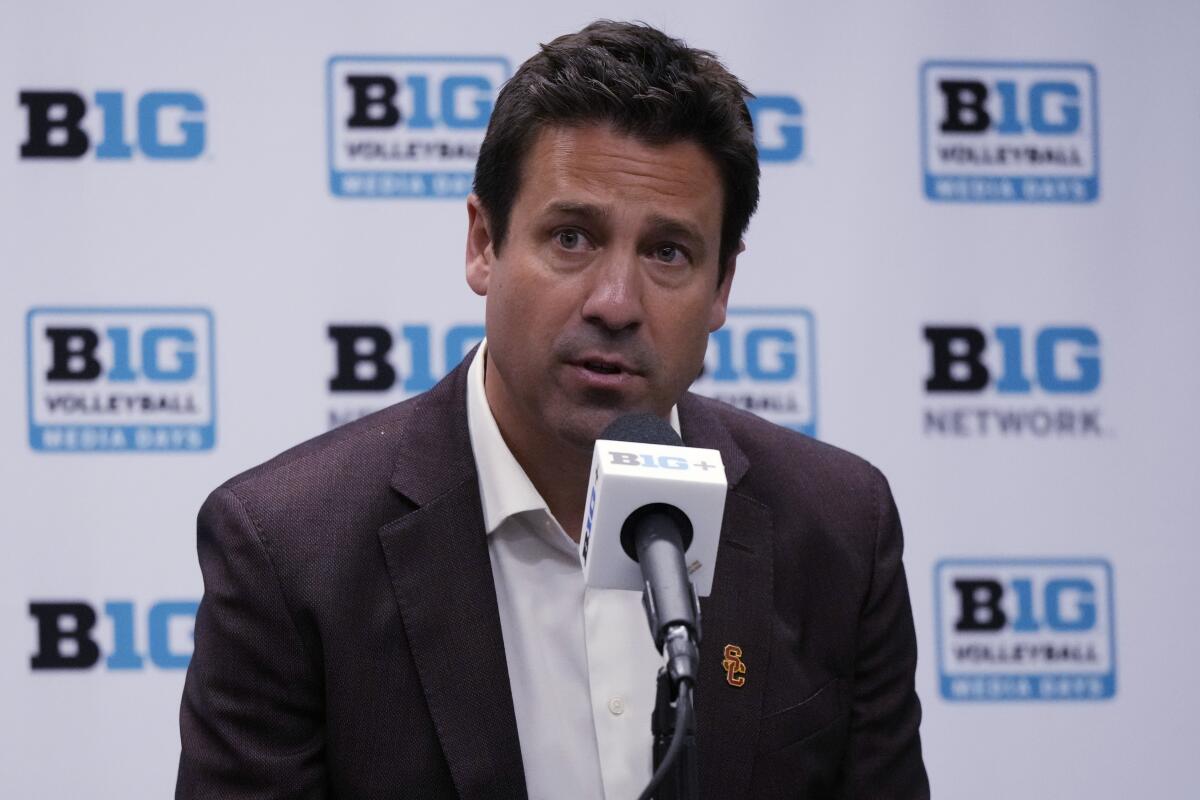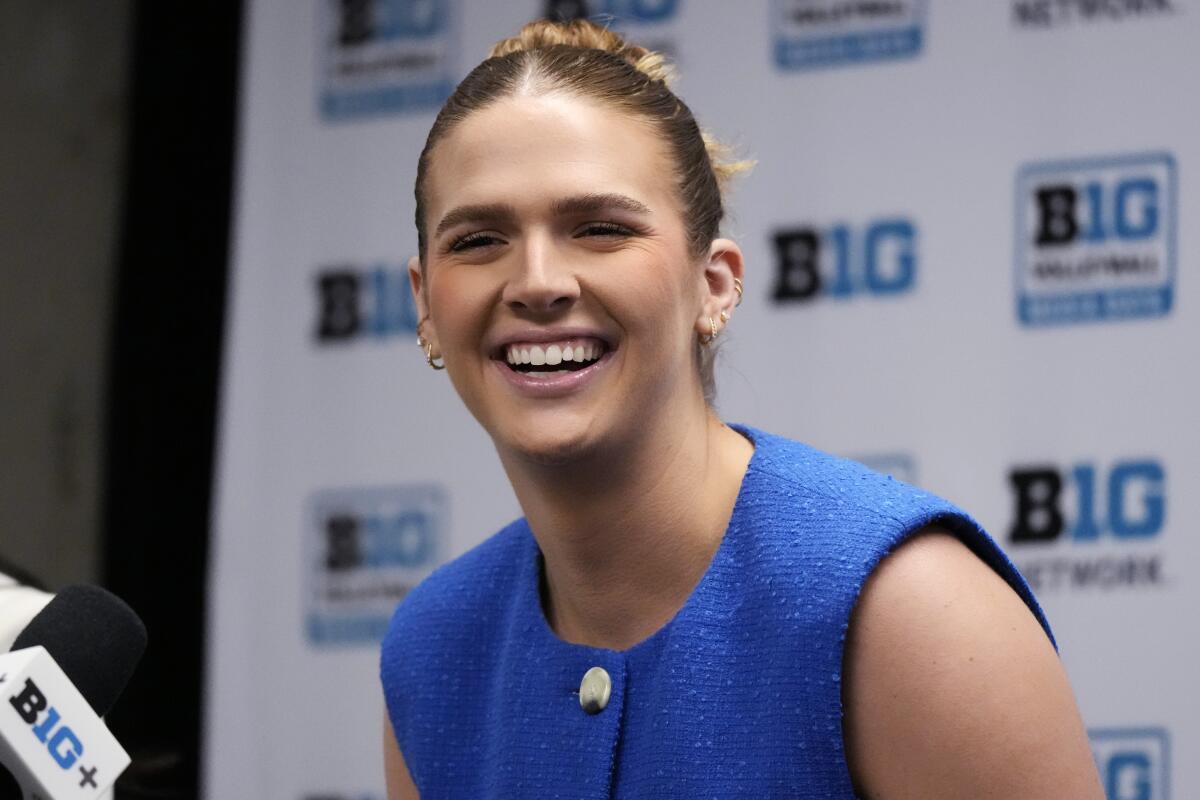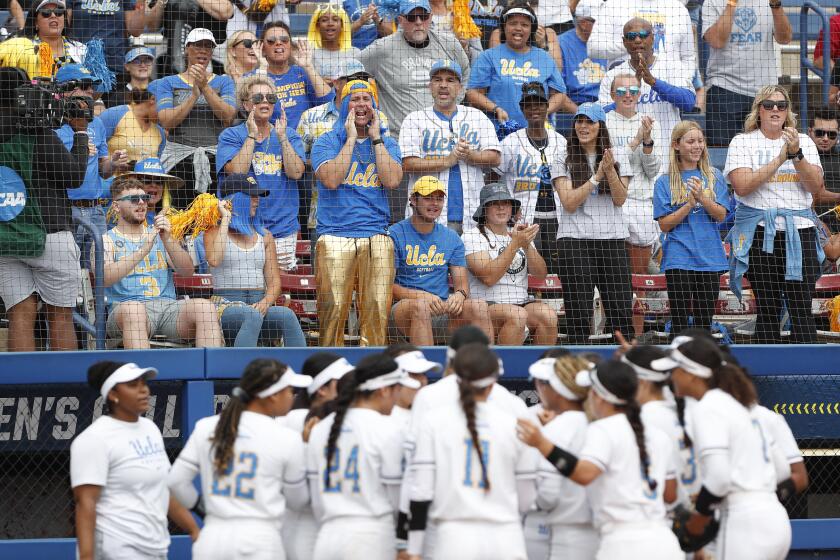What does UCLAâs and USCâs transition to the Big Ten look like for womenâs volleyball?

USC and UCLA officially joined the Big Ten Conference this month, which also means the start of womenâs volleyball season is drawing ever closer.
The Bruins and Trojans open their seasons Aug. 30, with their first matches against Big Ten opponents Sept. 27. The adjustment to a new conference isnât just about getting acquainted with teams of national championship caliber â Penn State and Nebraska have each won two titles since 2013, while Wisconsin won it all in 2021. There is also the reality of adjusting to a more grueling travel schedule.
Nebraska, last seasonâs national runner-up and USCâs first Big Ten road opponent, is a mere 1,537 miles away. The Bruins will have conference road trips to Purdue, Northwestern, Rutgers, Maryland, Indiana and Illinois. Rutgers, at about 2,800 miles, is the farthest Big Ten institution from the L.A. schools.
Gearing up for the season while protecting the health and wellness of the athletes starts with changing how the teams will travel. Second-year UCLA coach Alfee Reft said thereâll be some charter flights, depending on the timing of competition and athletesâ schedules. Bruins athletic director Martin Jarmond recently told The Times that four charter flights have already been approved for this season, with the possibility of more.
UCLA athletic director Martin Jarmond says heâs confident the Bruins are well-prepared for every aspect of their move to the Big Ten.
âThere are going to be some changes in how our travel looks and thatâs just a great testament to how great of a commitment our administration has to our athletes,â said Reft, whose team went 18-12 last season and missed the NCAA tournament for a second straight year.
USC will also see similar changes, with a transition from commercial to charter flights for quicker and more efficient travel. Efficiency will be key for both teams. For example, the Trojans open their Big Ten slate at home against Ohio State on Sept. 27, a Friday, then play at Nebraska two days later. The Bruins, meantime, will have their Indiana and Illinois road matches on consecutive nights Nov. 22-23.
âWe are still a college so we need to make sure to take care of the student-athlete as best as we can to be successful in the classroom and on the court,â said USC coach Brad Keller, whose team went 19-13 last season and lost in the second round of the NCAA tournament. âI canât speak highly enough of the amount of support we are getting, how involved they are with a positive mindset, and the consistency in what theyâre saying and how they act. Their delivery of leadership has been nothing short of phenomenal.â
The focus of these changes is centered on competitive equity, a principle in the NCAAâs constitution that says it will promote opportunity for equity in competition â such as with travel time, including waiting time in airports, that might put them at a disadvantage. These discussions occurred between the Big Ten and its volleyball coaches, including Reft, leading up to the transition.
âI put my hat off to the Big Ten and board of directors and everyone involved with the decisions,â said Reft, who also served as an assistant for the U.S. womenâs volleyball team, which won silver at the Paris Olympics. âI thought it was really a collaborative effort, I thought there were a lot of outlets for feedback both with scheduling and concerns specific to us. It seems as though weâve put a lot of legwork into making this as seamless of a transition as possible.â
Keller supports the decisions made in the transition period to the Big Ten and has worked with the USC administration to support the student-athletes as much as possible.
âOur board of trustees, our president and our AD, are on top of what we need to do for our student-athletes,â Keller said, adding: âItâs a new journey. There may be caution but at the end of the day you want to be a part of the best and thatâs what we get to do.â

After the announcement of UCLA joining the conference in June 2022, the administration continued to get feedback from student-athletes on the best plan to support them in and outside the classroom. Formal meetings were even conducted between university staff, administrators, and student-athletes across sports to develop ways the university can support student-athletes, such as in travel and mental health.
âWe presented challenges that may arrive, how to combat those, and what can be set up for different teams,â Bruins fifth-year middle blocker Anna Dodson said. âWe laid out what coaches, trainers and nutritionists can do to help and I felt like we were heard and supported by the whole university.â
Keller looks forward to the competition and fan support that comes with the Big Ten, but still has mixed feelings on the conference move.
UCLA, saddled with $102.8 million in athletic debt, wasnât sure it could keep fielding all sports before the moving from the Pac-12 to the Big Ten.
âI love the Pac-12, it was an incredible field of teams and amazing coaches so I was bummed about that,â Keller said, who is entering his fourth year at USC. âBut you move on with that and Iâm getting excited about the opportunity to be a part of one of the premier powerhouse conferences and play against some of the best teams in volleyball.â
Reft sees opportunity in the challenge ahead.
âThe Big Ten is the premier conference for womenâs volleyball,â said Reft, who served as an assistant at Minnesota from 2010 to 2012 and Illinois from 2018 to 2019. âWe get that opportunity night in and night out playing in the Big Ten so I think our staff and team is eager to go toe-to-toe with some of the best.â
Even if it means coming off a long flight to get there.
More to Read
Go beyond the scoreboard
Get the latest on L.A.'s teams in the daily Sports Report newsletter.
You may occasionally receive promotional content from the Los Angeles Times.









